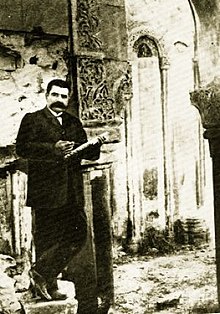Toros Toramanjan

Toros Toramanjan ( Armenian Թորոս Թորամանյան ; born March 18, 1864 in Şebinkarahisar , former Ottoman Empire ; † March 1, 1934 in Yerevan ) was an Armenian architect and historian . He is known as the "father of Armenian architectural historiography".
Life
Toros Toramanjan was born on March 18, 1864 in Şebinkarahisar (now Turkey ) in the former Ottoman Empire . His parents died at the age of 14. First he attended the local schools, but went to Constantinople in 1884 . After working as a bricklayer and stone worker for two years, he passed the entrance examination at the College of Fine Arts, where he studied architecture from 1886 to 1893 . Shortly after graduating in 1893, however, he had to leave the city due to the massacre of Sultan Abdülhamid II . He then lived in Belgium and Bulgaria, where he built his first buildings. From 1900 he also traveled to Romania, Egypt, Italy and Greece.
Two years later, Toramanjan settled in Paris, where he studied the history of architecture at the University of Paris . There he met Garabed Basmajian , with whom he traveled to Ani in 1903 to investigate the remains of the former Armenian capital. Difficult living conditions and lack of money forced him to move to the city of Etchmiadzin after four months . From 1904 he was at the archaeological excavations in the ruins of Zvartnots involved near Echmiadzin. Among other things, he examined the remains of the round church and presented the first results in 1905. From 1905 to 1909 Toramanian took part in annual excavation phases in Ani under the direction of the philologist Nikolai Marr of the Imperial Academy of St. Petersburg . As part of this expedition, Toramanjan examined many other monuments in the former Armenian capital and in the surrounding area, including the monasteries of Horomos , Tekor and Bagnayr . Toramanian published in scientific journals between 1907 and the 1930s. He was best known for his hypothetical reconstructions of destroyed church buildings, of which his model of the Zvartnots Cathedral is widely accepted to this day.
In 1913, Toramanian was sent to Vienna by the Austrian art historian Josef Strzygowski to give lectures on Armenian architecture and in particular on Ani. They also worked on a joint work based on Toramanian's research. After his return to Armenia, however, due to the outbreak of World War I , Toramanian was unable to return to Austria to complete work on the work. In 1918 Strzygowski still published the two-volume work entitled The Architecture of the Armenians and Europe , but only under his name. In addition, many of Toramanjan's works were lost due to the Ottoman invasion of Armenia.
After Armenia became part of the Soviet Union , Toramanian co-founded the Committee for the Preservation of Monuments . He also set up the Department of Architecture at the State Museum of Armenia , which he headed for two years.
Toramanjan died on March 1, 1934 at the age of 69 in Yerevan . He was also buried there in the Komitas Pantheon cemetery. The research results and materials for the two-volume work Materials for the History of Armenian Architecture , published posthumously in 1942 and 1948, were taken from its archives .
plant
- Niuter Hay Jartarapetutian Patmutian ( Material for the History of Armenian Architecture ), Volume 1 (Yerevan 1942) and Volume 2 (Yerevan 1948)
literature
- Ani T. Baladian: Le couvent de Horomos d'apres les archives de Toros Toramanian. Academie des inscriptions et Belle-Lettres, Paris 2002
- Christina Maranci: Medieval Armenian Architecture. Construction of Race and Nation. (Hebrew University, Armenian Studies 2) Peeters, Leuven 2001, pp. 43–70
- Hermine D. Varjabedian: The great 4: Mesrob, Komidas, Andranik, Toramanian. Shirak Press, Beirut 1969
Web links
- Toros Toramanjan on the Milwaukee Armenian Community website
- Death of Toros Toramanian (March 1, 1934). Biography of Toros Toramanjan on the This Week In Armenian History website, March 1, 2016
Individual evidence
- ^ Garbis Armen: An Architecture of Survival. 1992, p. 71 ( on books.google.de )
- ↑ Tomb of Toros Toramanjan on hush.am
- ↑ Tomb of Toros Toramanjan on findagrave.com
| personal data | |
|---|---|
| SURNAME | Toramanjan, Toros |
| BRIEF DESCRIPTION | Armenian architect and historian |
| DATE OF BIRTH | March 18, 1864 |
| PLACE OF BIRTH | Şebinkarahisar , Ottoman Empire |
| DATE OF DEATH | March 1, 1934 |
| Place of death | Yerevan , Armenia |
